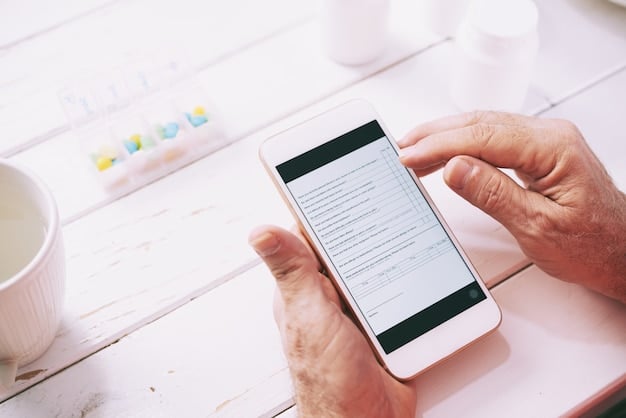Is Your Family Prepared? A Comprehensive Emergency Health Plan Guide

Creating a comprehensive emergency health plan ensures your family is prepared for unexpected health crises by including essential information, medical contacts, and a clear course of action.
Are you truly prepared to handle a health emergency in your family? Beyond the usual first-aid kit, a comprehensive strategy is crucial. This guide, “**Is Your Family Prepared? A Guide to Creating a Comprehensive Emergency Health Plan**,” provides the essential steps to safeguard your loved ones during unforeseen medical situations.
Why You Need an Emergency Health Plan
In today’s unpredictable world, having an emergency health plan is no longer a luxury—it’s a necessity. A well-thought-out plan can make the difference between a manageable situation and a chaotic crisis. It provides clarity, reduces panic, and ensures everyone knows their role when time is of the essence.
But what exactly does an emergency health plan entail? It’s more than just a list of phone numbers. It’s a comprehensive document that includes medical histories, insurance information, medication lists, and clear instructions on what to do in various emergency scenarios.
Understanding the Risks
Before diving into the details, it’s essential to understand the potential risks your family might face. Common emergencies range from sudden illnesses and accidents to natural disasters and public health crises. Each of these scenarios requires a different approach, making a versatile plan crucial.
- Sudden Illnesses: Conditions like heart attacks, strokes, or severe allergic reactions can strike without warning.
- Accidents: From minor falls to serious car crashes, accidents are a leading cause of emergency room visits.
- Natural Disasters: Hurricanes, earthquakes, and floods can disrupt medical services and leave families stranded.
- Public Health Crises: Pandemics such as COVID-19 highlight the need for plans that address widespread health emergencies.
Considering these risks allows you to tailor your plan to address the most likely emergencies in your area. For instance, if you live in an earthquake-prone zone, your plan should include steps for staying safe during and after an earthquake.
Ultimately, having an emergency health plan is about peace of mind. Knowing that you’ve taken steps to protect your family can reduce anxiety and empower you to act decisively when faced with a crisis. It’s an investment in your family’s well-being that can pay dividends in times of need.
Gathering Essential Medical Information
The cornerstone of any effective emergency health plan is accurate and readily available medical information. This includes everything from medical histories and current medications to allergies and insurance details. Having this information organized can save precious time in an emergency situation.
Creating a centralized repository for medical records ensures that first responders and healthcare providers have the necessary information to provide the best possible care. It also empowers family members to advocate for loved ones who may be unable to communicate their needs due to illness or injury.
Key Medical Information to Collect
Compiling a comprehensive list of medical information can seem daunting, but breaking it down into manageable steps makes the process easier. Here’s a checklist of essential information to gather:
- Medical History: Include a detailed history of each family member’s medical conditions, surgeries, and hospitalizations.
- Current Medications: List all medications, including dosages and frequency. Note any over-the-counter medications and supplements.
- Allergies: Document any known allergies to medications, foods, insect stings, or environmental factors.
- Insurance Information: Keep copies of insurance cards and policy numbers for health, dental, and vision coverage.
In addition to these basics, consider including information on vaccinations, chronic conditions, and any medical devices such as pacemakers or insulin pumps. The more thorough your information, the better prepared you’ll be.
Maintaining this information is an ongoing process. Regularly update the records to reflect any changes in medications, medical conditions, or insurance coverage. Consider setting reminders to review and update your family’s medical information at least once a year.
By systematically gathering and organizing essential medical information, you can create a valuable resource that will support your family during times of crisis. This proactive approach can ease stress, improve communication with healthcare providers, and ultimately, contribute to better health outcomes.
Creating a Family Medical Contact List
In an emergency, knowing who to contact can be as important as knowing what to do. A well-organized family medical contact list ensures that you can quickly reach the right people, whether it’s a primary care physician, a specialist, or an emergency contact. This list should be easily accessible and regularly updated.
Beyond the obvious contacts like doctors and family members, consider including other important individuals who can provide support and assistance during a health crisis. This might include neighbors, friends, or colleagues who are familiar with your family’s medical needs.
Essential Contacts to Include
Building a comprehensive contact list involves identifying the key individuals who can provide medical care, guidance, and support. Consider including the following contacts:
- Primary Care Physician: Your family doctor should be the first point of contact for most medical issues.
- Specialists: Include contact information for any specialists your family members see regularly, such as cardiologists, neurologists, or allergists.
- Emergency Contacts: List family members, friends, or neighbors who can be reached in case of an emergency. Include their phone numbers, addresses, and any relevant medical information they should know.
- Pharmacy: Keep the phone number and address of your preferred pharmacy handy for prescription refills and medication inquiries.
In addition to these primary contacts, consider including local hospitals, urgent care centers, and poison control centers in your list. It’s also a good idea to have contact information for your insurance company and any relevant support groups or helplines.
When creating your contact list, be sure to include multiple ways to reach each person. This might include phone numbers, email addresses, and even social media handles. It’s also important to test the contact information periodically to ensure it’s accurate and up-to-date.
By creating and maintaining a comprehensive family medical contact list, you can streamline communication during emergencies and ensure that you can quickly access the support and guidance you need. This simple step can make a significant difference in the outcome of a health crisis.

Developing an Emergency Communication Plan
Effective communication is essential during any emergency. Developing a family communication plan ensures that everyone knows how to stay in touch, where to meet if separated, and how to access important information. This plan should be simple, easy to remember, and regularly practiced.
Communication plans are especially important in situations where normal channels of communication may be disrupted, such as during a natural disaster or a power outage. Having alternative methods of communication in place can help prevent panic and ensure that everyone stays informed.
Key Components of a Communication Plan
A comprehensive communication plan includes several key elements, each designed to address different aspects of emergency communication. Consider the following components:
- Designated Meeting Place: Choose a location where family members can meet if they are separated during an emergency. This could be a nearby park, a community center, or a relative’s house.
- Out-of-State Contact: Designate an out-of-state contact person who can serve as a central point of communication for family members who are separated. This person should be someone who is reliable and has access to multiple communication channels.
- Emergency Contact Cards: Create wallet-sized cards that list emergency contact information, medical conditions, and any other relevant details. These cards should be carried by all family members.
In addition to these basics, consider establishing a family group chat on a messaging app like WhatsApp or Signal. This can be a quick and easy way to share updates and coordinate efforts during an emergency.
When developing your communication plan, be sure to involve all family members in the process. This will help ensure that everyone understands the plan and is comfortable with their roles and responsibilities. It’s also important to practice the plan regularly to identify any weaknesses and make necessary adjustments.
By creating and practicing an emergency communication plan, you can improve your family’s ability to stay connected and informed during times of crisis. This can reduce stress, prevent confusion, and ultimately, contribute to a more effective response.
Assembling a Comprehensive Emergency Kit
Having a well-stocked emergency kit is a crucial part of being prepared for any health crisis. This kit should include essential supplies such as first-aid materials, medications, food, water, and other items that can help your family survive during an emergency. The contents of the kit should be tailored to your family’s specific needs and regularly checked and updated.
An emergency kit is more than just a collection of random items. It’s a carefully curated set of supplies that can help you cope with a variety of emergency situations, from power outages and natural disasters to unexpected illnesses and injuries. Having a well-stocked kit can provide a sense of security and empower you to take care of your family when help may be delayed.
Essential Items for Your Emergency Kit
Building a comprehensive emergency kit involves gathering a variety of essential items that can help you meet your family’s basic needs during an emergency. Consider including the following items:
- First-Aid Supplies: A well-stocked first-aid kit should include bandages, antiseptic wipes, pain relievers, gauze pads, and any other items needed to treat minor injuries.
- Medications: Include a supply of any prescription medications that family members take regularly, as well as over-the-counter medications for common ailments like headaches, colds, and allergies.
- Food and Water: Store a three-day supply of non-perishable food and water for each family member. Choose foods that are easy to prepare and store, such as canned goods, granola bars, and dried fruits.
In addition to these basics, consider including items like a flashlight, a battery-powered radio, a multi-tool, a whistle, and a supply of cash in small denominations. It’s also a good idea to have copies of important documents like insurance cards, birth certificates, and passports in a waterproof container.
When assembling your emergency kit, be sure to choose high-quality items that are durable and reliable. It’s also important to store the kit in a cool, dry place that is easily accessible to all family members. Regularly check the contents of the kit to ensure that food and medications haven’t expired and that batteries are still working.
By assembling a comprehensive emergency kit, you can provide your family with the essential resources they need to survive and thrive during an emergency. This can give you peace of mind knowing that you’re prepared for whatever challenges may come your way.
Reviewing and Updating Your Emergency Plan
Creating an emergency health plan is not a one-time task. It’s an ongoing process that requires regular review and updates to ensure that the plan remains relevant and effective. As your family’s needs and circumstances change, so too should your emergency plan. Setting aside time to review and update your plan at least once a year is essential.
Failing to update your emergency plan can leave your family vulnerable in the event of a crisis. Outdated medical information, incorrect contact details, or expired supplies can all undermine the effectiveness of your plan. Regular reviews ensure that your plan is always ready to be put into action.
Key Steps for Reviewing and Updating
Reviewing and updating your emergency plan involves several key steps, each designed to identify areas for improvement and ensure that the plan remains current. Consider the following steps:
- Gather Feedback: Solicit feedback from all family members on the effectiveness of the current plan. Ask them what they think works well and what could be improved.
- Update Medical Information: Review and update all medical information, including medical histories, medications, allergies, and insurance details.
- Check Contact Lists: Verify that all contact information is accurate and up-to-date. This includes phone numbers, email addresses, and emergency contacts.
- Assess Emergency Kit: Examine the contents of your emergency kit to ensure that food and medications haven’t expired and that supplies are still in good condition.
In addition to these steps, consider conducting practice drills to test the effectiveness of your plan. This can help identify any weaknesses and give family members an opportunity to familiarize themselves with their roles and responsibilities.
When updating your emergency plan, be sure to document any changes and communicate them to all family members. This will help ensure that everyone is on the same page and that the plan remains effective in the event of an emergency.
By regularly reviewing and updating your emergency plan, you can ensure that it remains a valuable resource for your family. This proactive approach can provide peace of mind and empower you to respond effectively to any health crisis.
Educating Your Family on the Emergency Plan
Creating an emergency health plan is only half the battle. The other half is ensuring that all family members understand the plan and know how to execute it. Educating your family on the plan is essential for its success. This involves clear communication, practice drills, and ongoing reinforcement.
An emergency plan that is not understood by all family members is essentially useless. It’s important to involve everyone in the planning process and to provide them with the knowledge and skills they need to respond effectively during a crisis. This can help reduce panic, improve coordination, and ultimately, lead to better outcomes.
Effective Strategies for Family Education
Educating your family on the emergency plan requires a multifaceted approach that includes clear communication, hands-on training, and ongoing reinforcement. Consider the following strategies:
- Family Meetings: Hold regular family meetings to discuss the emergency plan, review key information, and answer any questions.
- Practice Drills: Conduct practice drills to simulate different emergency scenarios and allow family members to practice their roles and responsibilities.
- Educational Materials: Provide educational materials such as checklists, diagrams, and videos to reinforce key concepts and procedures.
In addition to these strategies, consider tailoring your approach to the age and abilities of your family members. Young children may benefit from simple, visual aids, while teenagers and adults may be able to handle more complex information.
When educating your family on the emergency plan, be sure to emphasize the importance of staying calm and following instructions. This can help prevent panic and ensure that everyone works together effectively during a crisis.
By investing the time and effort to educate your family on the emergency plan, you can empower them to respond confidently and effectively during a health crisis. This can provide peace of mind knowing that your loved ones are prepared and capable of taking care of themselves.
[Cabeçalho Coluna 1 em en-US]
[Cabeçalho Coluna 2 em en-US]
[Emoji 1 + Tópico Chave 1 em en-US]
[Descrição Breve 1 em en-US]
[Emoji 2 + Tópico Chave 2 em en-US]
[Descrição Breve 2 em en-US]
[Emoji 3 + Tópico Chave 3 em en-US]
[Descrição Breve 3 em en-US]
[Emoji 4 + Tópico Chave 4 em en-US]
[Descrição Breve 4 em en-US]
FAQ
▼
Your plan should include medical histories, current medications, allergies, insurance information, a family medical contact list, and an emergency communication plan.
▼
It is recommended to review and update your emergency health plan at least once a year, or whenever there are significant changes in your family’s health or circumstances.
▼
Include a first-aid kit, medications, a three-day supply of non-perishable food and water, a flashlight, a battery-powered radio, and copies of important documents.
▼
Hold regular family meetings to discuss the plan, conduct practice drills, and provide educational materials to reinforce key concepts and procedures.
▼
Carry a copy of the emergency health plan, including medical information and contact lists. Research local medical facilities and emergency services in advance.
Conclusion
In conclusion, creating and maintaining a comprehensive emergency health plan is a crucial step in safeguarding your family’s well-being. By gathering essential medical information, developing a communication strategy, assembling an emergency kit, and educating your family, you can significantly improve your ability to respond effectively during a health crisis. Remember, preparation is key to reducing stress, preventing confusion, and ensuring the best possible outcome for your loved ones.





